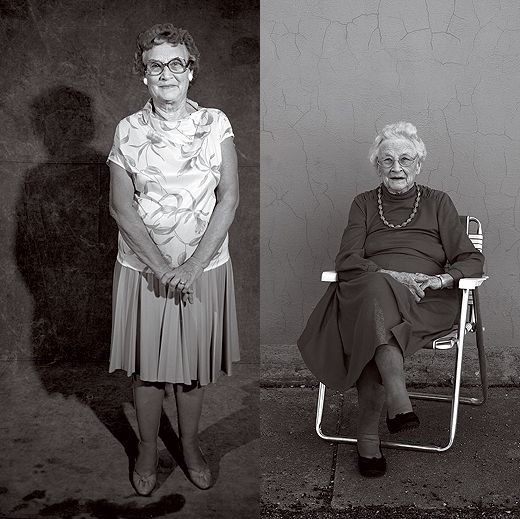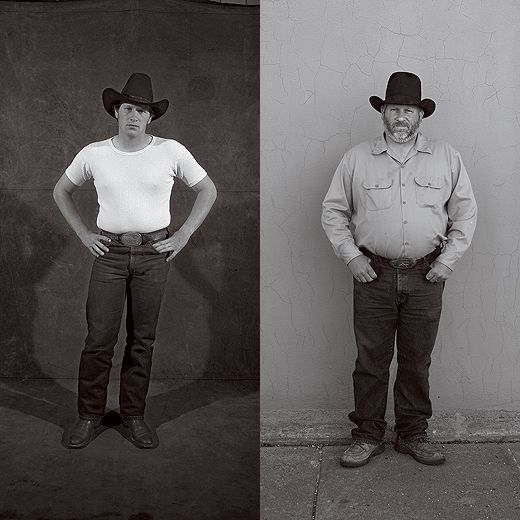Time and Again
In 1984, Peter Feldstein set out to photograph everyone in Oxford, Iowa. Two decades later, he’s doing it again, creating a portrait of heartland America
One sweltering summer day in 1984 my friend Peter Feldstein walked up and down the streets of Oxford, Iowa, posting fliers announcing he would take anyone's picture, free. At the time, 676 people lived in Oxford, and he wanted to make a photograph of every single one of them.
He set up a makeshift studio in an empty storefront across the street from where he lived. The first day, nobody showed up. Then some elementary-school students came by, then a retired couple, then a few more folks. After Peter photographed Al Sheets, a member of the local American Legion chapter, Sheets returned with 75 legionnaires and their families, and Peter's project took off.
He asked people to dress as they would on a typical Saturday afternoon. Clarence Schropp wore his wife's wig, and Calvin Colony brought his 300-pound pet lion, but mostly people were, well, themselves. Over three months, Peter photographed 670 people—a unique portrait of an American town, as comprehensive as any ever attempted.
Peter exhibited the pictures at the Legion hall in Oxford, and that was that. He filed the negatives away in a metal cabinet and went on teaching photography at the University of Iowa.
Last year, I suggested to Peter that he photograph the same people. Of course, many had died and some had moved away in the intervening 21 years. But most still live in Oxford. At last count, he had photographed more than 100 of them.
Peter didn’t pose them or even show them their original pictures. Yet Mary Ann Carter still tilted her head to the left, her hands cupped neatly at her side. Jim Jiras still wore his seed cap angled to the right. Pat Henkelman still leaned slightly to the left. Tim and Mike Hennes clasped their hands just the way they did before.
Many of the Oxfordians today are shorter or heavier or both. Some are stooped. Several cannot walk or breathe unassisted. Teeth are missing. At least three farmers have lost fingers. Electric smiles have dimmed. But there are also men and women in the radiance of life, exuberant, just coming into their prime.
Peter invited me to work with him. "Ask Oxford people to share their stories with you," he said. By now I’ve conducted dozens of interviews. Some people talk about religion, others about relationships gone bad. Some break down in tears, recalling incidents they had not, or rarely, acknowledged before. There is a great deal of courage in what people say. The language of not just a few is pure poetry.
"My father said I was the most beautiful baby in the most beautiful state, so he named me Iowa," said Iowa Honn, who was born in Oxford in 1910. "I met my husband in kindergarten."
"I'm the last living of the first four American soldiers who liberated Buchenwald concentration camp," Jim Hoyt said. "Seeing these things, it changes you. I was a kid. Des Moines had been the farthest I'd ever been from home."
"I'd love to travel Route 66, see New York City, Vegas, maybe Alaska," said Tim Hennes, recalling an abandoned plan to attend college in Hawaii. "Sometimes I feel like George Bailey, the Jimmy Stewart character in It's a Wonderful Life. That trip to Hawaii was my ticket out."
"I hope Oxford is my home forever," Mindy Portwood says. "My family is my world. My brothers, my sister, my parents are my best friends."
Oxford is only 16 miles from Iowa City, home of the University of Iowa and some 62,000 people, but it might as well be 1,000 miles. Founded in 1868, Oxford was originally a mail stop for stagecoaches and, later, trains. The name, suggested by a transplant from Oxford Township, New York, was pulled out of a hat. By 1880, Oxford boasted 891 residents, five general stores, one grocery store, three hardware stores, two drugstores, three hat stores, three hotels, three churches, two newspapers, two undertakers, three physicians, one dentist, four blacksmiths, three shoemakers and six saloons. Oxford even had an opera house. On September 18, 1948, a train carrying President Harry Truman pulled into town and he gave a five-minute speech—part of his whistle-stop campaign to defeat Republican challenger Thomas E. Dewey.
Oxford's mayor, Don Saxton, says the town’s glory days are pretty much gone. There's a Ford dealership, a bank, two beauty shops, a veterinarian, three saloons (if you count the American Legion hall) and one restaurant, which opens just for dinner. Oxford's population is now 705, an increase of 29 in the years since Peter began documenting the town. Two decades is a long time. Or is it? People change. Or do they? Peter's time-lapse photographs pose those questions, and they remind us of who we dreamed we would become and who we turned out to be.



